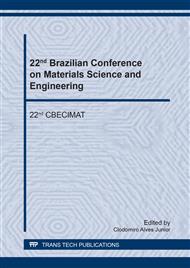p.283
p.293
p.299
p.305
p.311
p.317
p.322
p.327
p.333
Micromechanical Modeling of DP600 and DP800 Steels Plastic Behavior Based on the Mori-Tanaka Homogenization Method
Abstract:
The properties of the dual-phase steels are attributed to the chemical composition, type, size, amount, and spatial distribution of different phases that can be obtained during thermomechanical treatments. In this way, modeling of the mechanical behavior of the dual-phase steel constituents, namely, ferrite and martensite, is crucial to the numerical simulation of sheet metal forming processes mainly to forecast the residual stresses per phase. In this work, the microstructure of as-received DP600 and DP800 cold rolled steel sheets with 1.2 mm nominal thickness were firstly characterized by means of scanning electron microscopy technique. The grain sizes and volume fractions of ferrite and martensite phases were obtained by means of digital image analysis. The Mori-Tanaka homogenization scheme was implemented in the finite element code ABAQUS assuming linear isotropic elasticity and isotropic work-hardening behavior for both ferrite (matrix) and martensite (inclusion) phases. The numerical predictions obtained with the Mori-Tanaka homogenization scheme for the macroscopic uniaxial tensile behavior are in good agreement with the experimental curves of both dual-phase steels.
Info:
Periodical:
Pages:
311-316
Citation:
Online since:
September 2018
Price:
Сopyright:
© 2018 Trans Tech Publications Ltd. All Rights Reserved
Share:
Citation:


